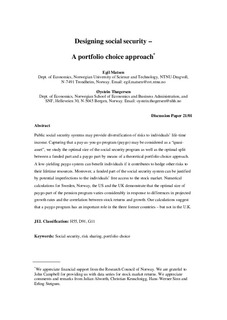| dc.contributor.author | Matsen, Egil | |
| dc.contributor.author | Thøgersen, Øystein | |
| dc.date.accessioned | 2006-08-10T11:09:25Z | |
| dc.date.available | 2006-08-10T11:09:25Z | |
| dc.date.issued | 2001-10 | |
| dc.identifier.issn | 0804-6824 | |
| dc.identifier.uri | http://hdl.handle.net/11250/162766 | |
| dc.description.abstract | Public social security systems may provide diversification of risks to individuals’ life-time
income. Capturing that a pay-as-you-go program (paygo) may be considered as a “quasiasset”,
we study the optimal size of the social security program as well as the optimal split
between a funded part and a paygo part by means of a theoretical portfolio choice approach.
A low-yielding paygo system can benefit individuals if it contributes to hedge other risks to
their lifetime resources. Moreover, a funded part of the social security system can be justified
by potential imperfections to the individuals’ free access to the stock market. Numerical
calculations for Sweden, Norway, the US and the UK demonstrate that the optimal size of
paygo-part of the pension program varies considerably in response to differences in projected
growth rates and the correlation between stock returns and growth. Our calculations suggest
that a paygo program has an important role in the three former countries – but not in the U.K. | en |
| dc.format.extent | 94101 bytes | |
| dc.format.mimetype | application/pdf | |
| dc.language.iso | eng | en |
| dc.publisher | Norwegian School of Economics and Business Administration. Department of Economics | en |
| dc.relation.ispartofseries | Discussion paper | en |
| dc.relation.ispartofseries | 2001:21 | en |
| dc.subject | social security | en |
| dc.subject | risk sharing | en |
| dc.subject | portfolio choice | en |
| dc.title | Designing social security : a portfolio choice approach | en |
| dc.type | Working paper | en |
